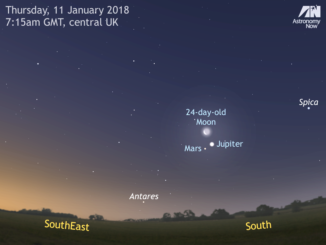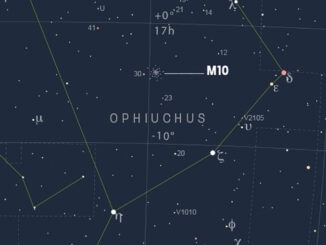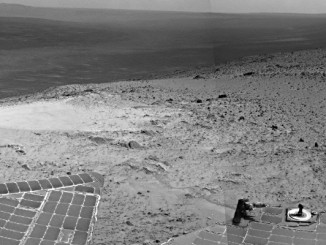
Mars is still moving prograde (i.e., from west to east) against the stellar backdrop of Libra and crosses the border into Scorpius on the evening of Sunday, 13 March. For the moment, though, it shines at magnitude +0.3 and on the morning of the first day of March lies 1.075 astronomical units, or 100 million miles (161 million kilometres) from Earth. Consequently, Mars is still quite small in the telescope, its 90 percent illuminated disc spanning just 8.7 arcseconds. To put this in context, you would need a magnification slightly in excess of 200x to enlarge it to the same diameter as the adjacent Moon appears to the unaided eye. Keep your eye on the red planet, however, as both its apparent size and magnitude grow as we approach Mars’ opposition in late May.
Saturn is also moving prograde against the stars of Ophiuchus, though its eastward motion is slowing to a stationary point on 25 March, whereupon its motion becomes retrograde (or east to west) in the run-up to its opposition in early June. As March opens, however, Saturn shines at magnitude +0.5 and the equatorial diameter of the planet spans 16.5 arcseconds — almost twice that of nearby Mars. The north pole of Saturn is tipped by slightly more than 26 degrees in our direction, hence the planet’s glorious ring system’s northern side is prominently displayed.
In early March the major axis of Saturn’s rings is approaching 38 arcseconds in width, meaning magnifications of slightly less than 50x and 110x are required to enlarge the rings and the planet, respectively, to the same diameter as the Moon appears to the unaided eye. On the morning of 1 March, Saturn lies 10.05 astronomical units, or 934 million miles (1,504 million kilometres) from Earth — or 9⅓ times as far away as Mars.
Don’t forget to use our interactive online Almanac to provide a wealth of planetary observational data for wherever you may find yourself in the world.
Inside the magazine
Find out everything you need to know about observing the planets and everything else currently happening in the night sky between the pages of the March 2016 edition of Astronomy Now.
Never miss an issue by subscribing to the UK’s biggest astronomy magazine. Also available for iPad/iPhone and Android devices.




